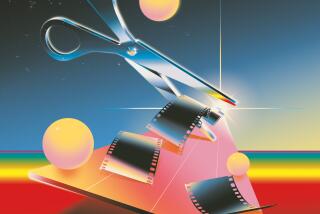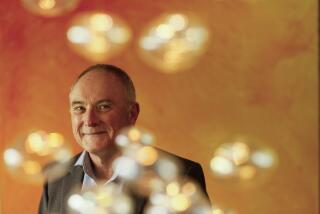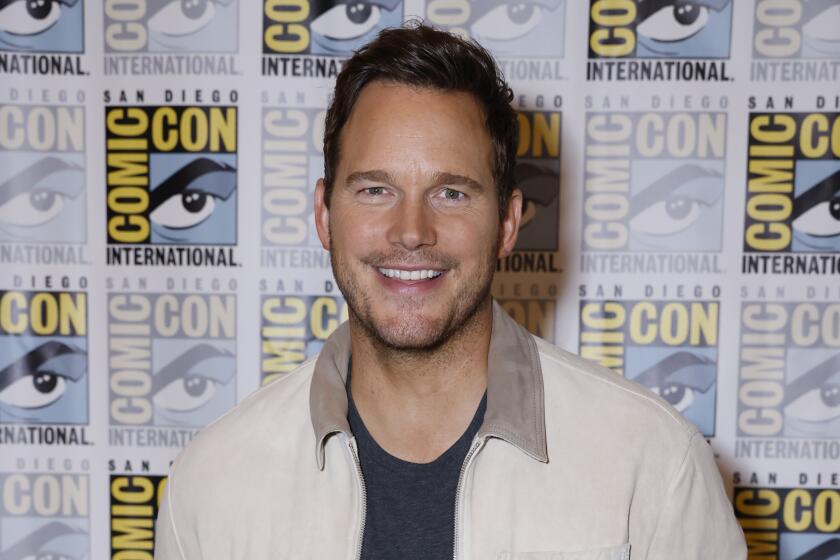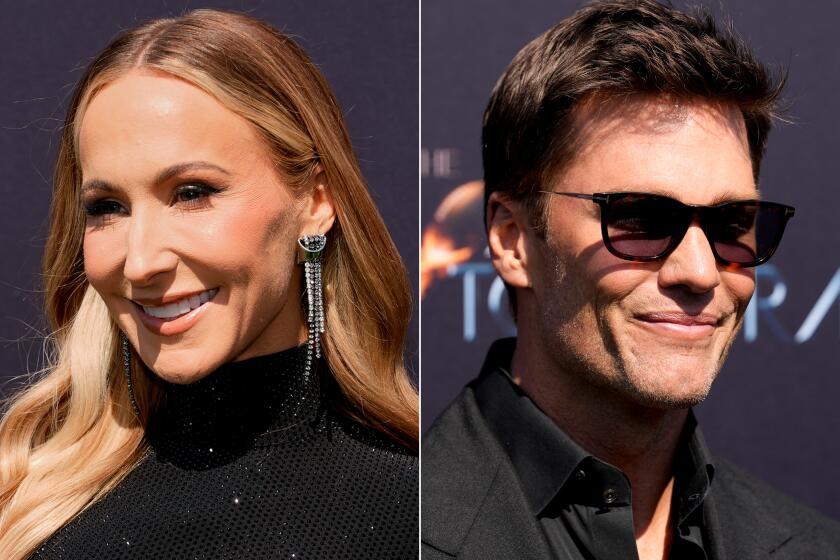For ‘Cutie and the Boxer’ director, a labor of art and love
An up-close, warts-and-all look at an aging couple’s marriage and lives as artists would be a challenging subject for any documentary film director, let alone a first-timer. With “Cutie and the Boxer,” Zachary Heinzerling not only took on the task, he took it on in a language he doesn’t speak — Japanese. The movie, which he filmed largely at the immigrant couple’s New York loft, debuted at the Sundance Film Festival in January, and Heinzerling won for director there. Now open in Los Angeles, the film has a 97% fresh rating on the review aggregation site Rotten Tomatoes.
We sat down with Heinzerling in Los Angeles last week to talk to him about the film.
Q. How did you capture your subjects, Ushio and Noriko Shinohara, so well, given that throughout most of the film they are speaking Japanese?
A. I don’t speak Japanese. I can understand a little bit. I would have a general idea of what they were saying. But for most of the scenes that were used in the film, there was no translator, it was just me filming them and their conversations. Sometimes it would just be hours, I would just film the entire conversation and have it translated, and sort of script the scene out of the entire conversation. Later, I had interns and subtitlers — a team of four or five that were doing different things.
I think working this way allowed Noriko and Ushio to have the peace of mind that when they said something, they didn’t know what was intriguing to me and what wasn’t, they didn’t know what was more important than other things. It’s a very inefficient way to make a film because you end up just having massive amounts of material, and you have to do everything after the fact to really determine the story. I also found it peaceful, getting into the rhythm of their life and their speech patterns, and not worrying about what it looked like and sounded like, and the tone of the scene as opposed to concentrating on, ‘Oh, I need to move in on this moment.’ And instead of being more of a conversation between me and them, it was more of a conversation they were having with each other, with me being relatively absent and not asking for something to be repeated, or ask for clarification on something. Then I would go back. … I think the movie really rests on those quieter moment and those conversations that are very real. That was what was most attractive. But you also have to have a story.
Q. How long did you spend with them, and how much footage did you gather?
A. I met them five years ago. The first year, I didn’t shoot much. The footage from the movie was from the last two years of shooting. It’s really their life over the course of two years, with a year of editing. I ended up with about 300 hours of footage, plus archival material.
PHOTOS: Celebrities by The Times
Q. Some of the most poignant moments come from archival footage from the 1970s. Where did you get that?
A. All those home videos came from a trove.… Ushio had this friend that came over from Japan in the early ‘80s and brought over this Sony Hi-8 camera. He filmed a month of parties, them getting drunk. Their loft was like ground zero for crazy artists, Japanese expats, also Americans. They would just have these wild, late parties. He would set the camera up and film them in their entirety. And he made a documentary out of it, but it was more like a home video project and it never aired. I saw some of it and it was so much more raw than any other footage I had seen of him. There are a lot of more explicit scenes in that footage than I used. But the scene of him breaking down is one of the most powerful scenes in the movie, and I didn’t shoot it.
Q. When you showed them the film at first, what did they think?
A. Ushio didn’t like the film when he first saw it. We turned the movie off, and Ushio said, ‘Is this a love story?’ And I was like, ‘Yes,’ and he was like, ‘Yuck!’ ... He thought it was too much about Noriko. I had shot all this other stuff with him, and he was like, where is this, where is this? Why isn’t there more of my art in it? And Noriko would try to chime in and explain what had happened. He wasn’t angry, he was just critical, but never to the point where he was, like, you have to change it. …
Every time he sees it he has something new to say about it. He talks about their relationship in a new way, he talks about Noriko’s art in a new way. ... His favorite scene is the one [from archival footage] where he’s crying and breaks down. … He thinks it’s the most honest point in the whole movie, mostly because he doesn’t remember it and wasn’t necessarily conscious of acting during that period.
He’s also talked about how the [film] crowds have energized him. There have been some standing ovations. In the art world, everything is very quiet and measured and he likes the kind of gut reaction that the film can induce.
INDIE FOCUS: Coverage of independent film
Q. Did you ever worry that your film might cause the breakup of their marriage?
A. People ask me that. It could go either way; I think it strengthened their marriage, probably. That’s my own opinion. But I’m never worried that they’re going to break up. It’s been too long. They’re very kind of fatalistic. She’s like: I chose Ushio, I made the sacrifice, I had a child with him and she’s sort of been standing by ever since. Because her psyche has been so determined by her relationship to him and his world, that’s who she is. Which is another interesting thing I’ve thought about.
I can’t really say that Noriko could have been something else, or could have changed or made the wrong decision or something. Because I only know her as this person who has been defined by him. I’m not sure she even thinks of it in terms of regret, or not – it’s just the way it is. In some ways, it’s like it couldn’t get much worse. But it’s also really good in some ways. The film has made them think about and see the breadth of their relationship. … I think they’ve seen their relationship in a new way because of the film and it’s never something I intended. The film was primarily for other people; it was never intended as a form of therapy for them. It was probably more therapeutic for me than for them.
Q. In what way?
A. I think I had a maybe innocent view of love and relationships. People say it seems mature of a young filmmaker to make a love story about an older couple. But I think it’s more that it was something I didn’t know and something I was more interested in because of my naivete, trying to find out what makes this relationship work because it’s not the typical things that make a relationship work. You can’t really determine what it is. But for me, personally, I analyze my relationships to the bones, and try to determine exactly why something is or isn’t working, what it is about this person that’s affecting me in some way. It was an education in relationships.
Q. Has their relationship changed since the film?
A. Ushio was asked this by someone, and he said that he and his wife had fought for 40 years but he didn’t realize she loved him until he watched the movie. And someone asked me, “Zach, how does that make you feel?” It sort of made me consider my role in a different way. There’s always the dilemma in documentary of how you portray someone and the ethics behind that but it’s rarely discussed that you might affect someone’s relationship with their loved one. I almost think that it made me feel nervous about being in that position. Am I constructing a narrative that now Ushio is changing by? If he could only objectively view his marriage once he had seen this movie – which is completely subjective and completely my own projection – then … well, that seems to affect him in a deeper way than just, oh the film is in the public and his name as an artist is recognized more. That kind of comes along with any documentary.
But affecting someone in how they view their relationship was different, deeper and made me think about whether the relationship I had depicted was completely honest or whether I was pushing an intimacy, a romance, and pushing the idea that it was a love story further just because I enjoyed that and wanted it. It’s true, they never talked about love openly until I would bring it up. Until we have this art show, “Love is a Roarrr,” and these conversations about their relationship that they weren’t having before I was filming, and they kind of thought about and processed and are now being asked questions about – it just feels like a level of intimacy that I didn’t necessarily imagine or feel before or while I was filming.
PHOTOS: Hollywood backlot moments
Q. The film was given an “R” rating by the MPAA for “nude art images.” What do you think about that?
A. I didn’t really get involved but what I was told was that there are paintings of an erect penis in Noriko’s comics, and apparently even an erect penis that is part of art is grounds for an R rating. So technically it’s R for nude art images. We would have had to obviously change something in the film, and we didn’t want to compromise the art for the sake of the rating. So maybe it’s something we could have fought, but I’m not sure. I guess I suspected it wouldn’t change things. But it’s definitely a little weird.
We can’t use her art in our poster because when she draws the “Cutie” comics, she’s naked in them, and drawn breasts can’t be used in a public poster, according to the MPAA. It’s really bizarre.
Q. What’s happened with them and their art since the movie has been finished?
A. We had an art show at Sundance, and he sold a boxing painting there, which was sort of a big deal, they’re the most highest priced of his works. That was really cool. We’re working on publishing a book for her. It’s not quite there yet but there’s interest, so we’re trying to put out a book of her Cutie and Bullie the comic story, which she’s super excited about. …. We are doing a theatrical release in Japan in December. It’s exciting for them, they are also doing an exhibition in Japan; Ushio, Noriko and their son will all be showing at a pretty famous gallery. They’re excited about that.
Q. What’s your relationship with them like now?
A. I think my relationship with them now is much more neutral in a way. It’s a bit unbalanced when you’re the one with a camera and you’re the once asking all the questions. The majority of the times when I came, I’d have the camera, so immediately you start from the place of I’m the investigator and you’re the subject. So your relationship is kind of founded on that. When you don’t have the camera, you start being asked questions, and your life becomes more of a topic of discussion and it feels much more even, much healthier in some ways.
ALSO:
Review: Artistry, marriage at heart of ‘Cutie and the Boxer’
PHOTOS AND MORE
VIDEO: Upcoming summer films
ENVELOPE: The latest awards buzz
PHOTOS: Greatest box office flops
More to Read
Only good movies
Get the Indie Focus newsletter, Mark Olsen's weekly guide to the world of cinema.
You may occasionally receive promotional content from the Los Angeles Times.







